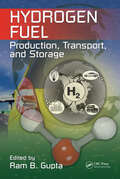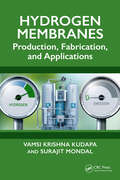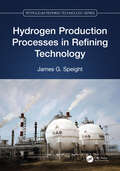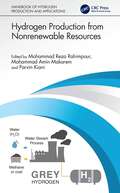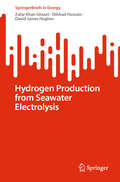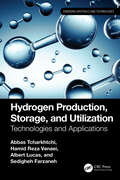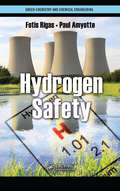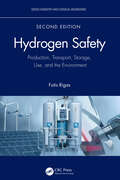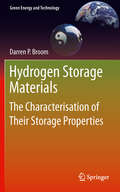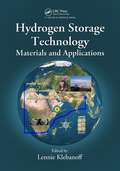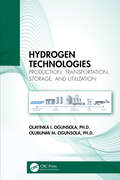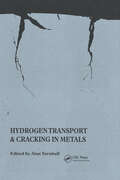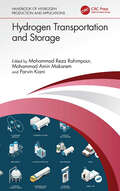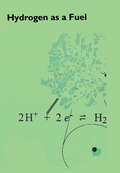- Table View
- List View
Hydrogen Fuel: Production, Transport, and Storage
by Ram B. GuptaFrom Methane to Hydrogen-Making the Switch to a Cleaner Fuel Source The world's overdependence on fossil fuels has created environmental problems, such as air pollution and global warming, as well as political and economic unrest. With water as its only by-product and its availability in all parts of the world, hydrogen promises to be the next grea
Hydrogen Membranes: Production, Fabrication, and Applications
by Vamsi Krishna Kudapa Surajit MondalThis book provides an overview of the most recent advances and innovations in the subject of hydrogen separation, its applications, and the role of membranes in this process. It starts with the fundamental principles underlying hydrogen separation and the various types of membranes that are used for hydrogen separation. Furthermore, it explains different fabrication methods, including characterization techniques used to evaluate performance and properties. Finally, it covers diverse applications of hydrogen separation membranes backed by case studies and examples.Features: Covers several forms of hydrogen membranes, such as polymeric, metallic, and ceramic membranes and provides a thorough understanding of their manufacturing, construction, and applications Explores recent advancements in materials used for the fabrication of hydrogen membranes Focuses on theoretical concepts and practical applications of hydrogen separation membranes Explains the role of hydrogen membranes in the transition toward a sustainable energy future Discusses real-world case studies, industrial applications, and potential future uses Emphasizes real-world applications of hydrogen membranes in fields such as fuel cells, hydrogen generation, and carbon capture This book is aimed at academics, energy professionals, engineers, researchers, and scientists working on sustainable energy solutions. Readers will obtain a detailed grasp of hydrogen membrane technology, from basic principles to sophisticated applications, giving them the capacity to innovate further.
Hydrogen Production Processes in Refining Technology (Petroleum Refining Technology Series)
by James G. SpeightThis book details the various approaches to the production of hydrogen in petroleum refining. The need for hydrogen is addressed, and then the differences between the processes are detailed. This practical and accessible guide is written for managers, professionals, and technicians as well as graduate students transitioning into the refining industry.Key Features: Describes hydrogen purification methods and processes, providing relevant process data and fully describing process operations Describes hydrogen purification methods and processes, detailing the types of feedstock that can be used and exploring the options and parameters of each process Details commercial processes, including gasification pretreatment and reactions and considers next-generation processes and developments
Hydrogen Production by Water Splitting, Storage and Transportation: From Laboratories to Industries
by Imran Ali Gunel T. Imanova Al Arsh BasheerThis book provides a comprehensive understanding of the process of hydrogen production by water splitting, including materials used, methods and instrumentation. It discusses hydrogen production methods with a focus on water splitting (laboratory/industrial scales) followed by its storage and perspectives. It describes all the methods of hydrogen production, i.e., water electrolysis, steam electrolysis, steam reforming, membrane electrolysis and water splitting. The effects of various radiations (ultraviolet, visible, gamma, X-ray and infrared) on hydrogen production are also included.Features: Presents a complete collection of hydrogen generation and discusses the water spitting process in detail. Explores the effects of the radiation of hydrogen generation. Discusses hydrogen generation and storage on a large scale. Presents a future perspective of hydrogen as fuel. Includes future challenges and perspectives to produce hydrogen economically on a large scale. This book is aimed at graduate students and researchers in materials and chemical engineering, radiation science, physics, chemistry and materials science.
Hydrogen Production from Nonrenewable Resources
by Mohammad Reza Rahimpour Mohammad Amin Makarem Parvin KianiThe conventional generation of a substantial quantity of hydrogen from resources based on fossil fuels continues to play an essential role in the hydrogen economy. Hydrogen Production from Nonrenewable Resources offers a comprehensive overview and features three sections covering properties and characteristics of hydrogen, technologies for converting nonrenewable sources to hydrogen, and challenges in synthesis and production. Details of thermophysical characteristics and properties of hydrogen Covers conventional and novel industrial technologies for efficient production Explores environmental opportunities and challenges and health and safety regulations Provides techno‑economic and lifecycle assessments with future outlooks Part of the multivolume Handbook of Hydrogen Production and Applications, this standalone book guides researchers and academics in chemical, environmental, energy, and related areas of engineering interested in the development and implementation of hydrogen production technologies.
Hydrogen Production from Nuclear Energy
by Calin Zamfirescu Ibrahim Dincer Greg F. NatererWith the resurgence of nuclear power around the world, and the increasingly important role of hydrogen as a clean energy carrier, the utilization of nuclear energy for large-scale hydrogen production will have a key role in a sustainable energy future. Co-generation of both electricity and hydrogen from nuclear plants will become increasingly attractive. It enables load leveling together with renewable energy and storage of electricity in the form of hydrogen, when electricity prices and demand are lowest at off-peak hours of nuclear plants, such as overnight. Hydrogen Production from Nuclear Energy provides an overview of the latest developments and methods of nuclear based hydrogen production, including electrolysis and thermochemical cycles. Particular focus is given to thermochemical water splitting by the copper-chlorine and sulphur-based cycles. Cycle configurations, equipment design, modeling and implementation issues are presented and discussed. The book provides the reader with an overview of the key enabling technologies towards the design and industrialization of hydrogen plants that are co-located and linked with nuclear plants in the future. The book includes illustrations of technology developments, tables that summarize key features and results, overviews of recent advances and new methods of nuclear hydrogen production. The latest results from leading authorities in the fields will be presented, including efficiencies, costs, equipment design, and modeling.
Hydrogen Production from Renewable Resources and Wastes
by Mohammad Reza Rahimpour Mohammad Amin Makarem Parvin KianiThis book provides readers with a comprehensive overview of the processes and technologies utilized for producing hydrogen from renewable sources. It discusses common methods like gasification, pyrolysis, and liquefaction, along with novel methods like water thermochemical splitting, biophotolysis, biological water‑gas shift reaction, and fermentation processing. The application of various renewable sources, including wind, solar, and geothermal energy, is covered in detail. Introduces water splitting conversion processes for hydrogen production in detail Uniquely provides different pyrolysis, gasification, and liquefaction processes for hydrogen generation Covers different biomass and waste sources for producing hydrogen Discusses biochemical methods for converting biomass to hydrogen Provides the application of renewable energy sources in hydrogen production Part of the multivolume Handbook of Hydrogen Production and Applications, this standalone book guides researchers and academics in chemical, environmental, energy, and related areas of engineering interested in the development and implementation of hydrogen production technologies.
Hydrogen Production from Seawater Electrolysis (SpringerBriefs in Energy)
by Zafar Khan Ghouri Dilshad Hussain David James HughesThis brief provides an in-depth exploration of seawater splitting electrocatalysts, emphasizing critical challenges such as sustaining high current density, achieving oxygen evolution reaction (OER) selectivity, and utilizing earth-abundant materials. It offers insights into the current landscape of seawater electrolyzer technologies and emerging alternatives. The book also discusses rational design approaches aimed at developing highly active and stable electrocatalysts capable of industrial-scale current densities without degradation, with a focus on achieving selective oxygen evolution over chlorine evolution. Recent advancements in seawater electrocatalysts, including transition metal oxides, nitrides, sulfides, phosphides, and carbides, are examined. Additionally, it highlights promising strategies for electrocatalyst and electrolyzer design, as well as unconventional operating parameters. making it a valuable resource for graduates and researchers active in the fields of electrocatalysis and green technologies.
Hydrogen Production, Storage, and Utilization: Technologies and Applications (Emerging Materials and Technologies)
by Hamid Reza Vanaei Abbas Tcharkhtchi Albert Lucas Sedigheh FarzanehHydrogen Production, Storage, and Utilization: Technologies and Applications presents a comprehensive and in-depth exploration of the scientific and engineering principles of hydrogen technology. Written in a technical and scientific manner, using rigorous scientific language and mathematical models to explain principles and applications, the book covers various aspects of hydrogen technology, ranging from fundamental principles of thermodynamics and kinetics to practical applications of hydrogen production, storage, and utilization. Includes chapters on the latest advances in hydrogen production, including methods such as steam methane reforming, electrolysis, and biomass gasification Expresses the scientific principles of hydrogen storage, including metal hydrides, carbon-based materials, and liquid carriers Discusses the latest research on fuel cell technologies, including proton-exchange membrane fuel cells, solid oxide fuel cells, and microbial fuel cells Covers hydrogen safety aspects, including risk assessment, safety protocols, and safety standards Explores the challenges and opportunities associated with the deployment of hydrogen technology, including economic viability, environmental impact, and social acceptance The book is intended for scientists, engineers, researchers, and graduate students in the fields of chemical engineering, materials science, renewable energy, and sustainability, as well as policymakers and stakeholders interested in the potential of hydrogen as a clean and renewable energy carrier.
Hydrogen Purification and Separation
by Mohammad Reza Rahimpour Mohammad Amin Makarem Parvin KianiThe purification of hydrogen is necessary to fulfill purity standards of a wide variety of prospective uses, and it is also a key concern regarding the efficient supply of hydrogen. Hydrogen Purification and Separation reviews various hydrogen separation methods as well as membranes used in hydrogen separation. It discusses absorption and adsorption methods, as well as novel technologies such as cryogenic methods and plasma‑assisted technology, and the related economic assessments and environmental challenges. Introduces miscellaneous membrane‑assisted processes for hydrogen separation Provides different physiochemical absorption methods for hydrogen purification Discusses application of sorbents and swing technologies in hydrogen purification Uniquely covers hydrogen separation using novel methods Includes economic assessments and environmental challenges of hydrogen purification in detail Part of the multivolume Handbook of Hydrogen Production and Applications, this standalone book guides researchers and academics in chemical, environmental, energy, and related areas of engineering interested in development and implementation of hydrogen production technologies.
Hydrogen Safety (ISSN #13)
by Fotis Rigas Paul AmyotteHydrogen Safety highlights physiological, physical, and chemical hazards associated with hydrogen production, storage, distribution, and use systems. It also examines potential accident scenarios that could occur with hydrogen use under certain conditions. The number of potential applications for hydrogen continues to grow-from cooling power statio
Hydrogen Safety: Production, Transport, Storage, Use, and the Environment (ISSN)
by Fotis RigasWhile hydrogen is of vital and growing importance in many industrial sectors, this volatile substance poses unique challenges, including easy leakage, low ignition energy, a wide range of combustible fuel– air mixtures, buoyancy, and its ability to embrittle metals that are required to ensure safe operation. Updated to include the latest advances in the decade since original publication, Hydrogen Safety, Second Edition highlights physiological, physical, and chemical hazards associated with hydrogen production, storage, distribution, and usage systems. Focused on providing a balanced view of hydrogen safety – one that integrates principles from physical sciences, engineering, management, and social sciences – this book is organized to address questions associated with the hazards of hydrogen and the ensuing risks associated with its industrial and public use. This book: Addresses issues of inherently safer design, safety management systems, and safety culture. Features updated case studies of significant accidents involving hydrogen, along with their detailed analysis and lessons learnt, and potential accident scenarios under certain conditions. Details current research trends and perspectives on materials- based hydrogen storage solutions, hydrogen use in vehicles, and hydrogen in construction materials. Describes Process Safety Management as applied to the process industries, in conjunction with the components of the US Department of Energy Safety Plant Elements for hydrogen safety, and covers activities of the European Commission (EC) Network of Excellence for Hydrogen Safety (HySafe). Includes updated codes for gaseous and liquefied hydrogen and the NFPA 2 Hydrogen Technologies Code. Concludes with research and legal requirements. Offering a holistic view of hydrogen safety, from properties to safety systems, this book helps readers in chemical, industrial, safety, and related engineering subjects ensure a safe application and environment.
Hydrogen Storage Materials
by Darren P. BroomThe problem of storing hydrogen safely and effectively is one of the major technological barriers currently preventing the widespread adoption of hydrogen as an energy carrier and the subsequent transition to a so-called hydrogen economy. Practical issues with the storage of hydrogen in both gas and liquid form appear to make reversible solid state hydrogen storage the most promising potential solution. Hydrogen Storage Materials addresses the characterisation of the hydrogen storage properties of the materials that are currently being considered for this purpose. The background to the topic is introduced, along with the various types of materials that are currently under investigation, including nanostructured interstitial and complex hydrides, and porous materials, such as metal-organic frameworks and microporous organic polymers. The main features of Hydrogen Storage Materials include: an overview of the different types of hydrogen storage materials and the properties that are of interest for their practical use;descriptions of the gas sorption measurement methods used to determine these properties, and the complementary techniques that can be used to help corroborate hydrogen uptake data; andextensive coverage of the practical considerations for accurate hydrogen sorption measurement that drive both instrument design and the development of experimental methodology.Hydrogen Storage Materials provides an up-to-date overview of the topic for experienced researchers, while including enough introductory material to serve as a useful, practical introduction for newcomers to the field.
Hydrogen Storage Technology: Materials and Applications
by Lennie KlebanoffZero-carbon, hydrogen-based power technology offers the most promising long-term solution for a secure and sustainable energy infrastructure. With contributions from the world's leading technical experts in the field, Hydrogen Storage Technology: Materials and Applications presents a broad yet unified account of the various materials science, physi
Hydrogen Sulfide and Plant Acclimation to Abiotic Stresses (Plant in Challenging Environments #1)
by M. Nasir Khan Francisco J. Corpas Manzer H. Siddiqui Saud AlamriThis book focuses on the role of hydrogen sulfide in the protection of plants against abiotic stresses and abiotic stress-induced complications by the way of converging advanced key methods of proteomics, genomics, and metabolomics. It provides an update on the biosynthesis, signaling, and mechanism of action of hydrogen sulfide in combating abiotic stresses in plants. Also, special emphasis is given to the interaction of hydrogen sulfide with other signaling molecules (such as nitric oxide, carbon monoxide, hydrogen peroxide etc.), phytohormones, mineral nutrients, ions, and ion channels in plants. This work, uniquely, covers key aspects of hydrogen sulfide signaling in relation to abiotic stresses in plants, including programmed cell death, stomatal movement, and fruit ripening.
Hydrogen Technologies: Production, Transportation, Storage, and Utilization
by Olayinka I. Ogunsola Olubunmi M. OgunsolaOffering a wide-range coverage, this book provides fundamentals as well as the applied science and technology involved in the whole hydrogen value chain, including production, storage, transportation, and utilization. It discusses some challenges and opportunities for hydrogen to address energy demand and climate change issues.Features: Discusses various technology pathways for manufacturing/producing hydrogen both directly (i.e., water splitting) and indirectly (i.e., gas, conversion of coal, and biomass). Covers techniques and technologies for transporting gaseous, liquid, solid, and other forms of hydrogen, including mobile and stationary modes as well as small- and large-scale forms of transportation. Offers techniques and technologies for storing hydrogen with emphasis on materials and physical and chemical characteristics. Describes hydrogen utilization in energy/energy conversion, industrial chemical, industrial agricultural, and transportation sectors. This book is aimed at engineers and scientists working in the disciplines of energy, chemical, environmental, petroleum, petrochemical, and mechanical engineering.
Hydrogen Transport and Cracking in Metals: Proceedings of a Conference Held at the National Physical Laboratory, Teddington, UK, 13-14 April 1994
by Alan TurnbullProceedings of a Conference Held at the National Physical Laboratory, in Teddington, UK, on the 13-14 April 1994, with the main focus of Hydrogen Transport and Cracking in Metals.
Hydrogen Transportation and Storage
by Mohammad Reza Rahimpour Mohammad Amin Makarem Parvin KianiThe success of hydrogen energy markets depends on developing efficient hydrogen storage and transportation methods. Hydrogen may be stored in various ways, including compression, liquefaction, adsorption, hydrides, and reformed fuels. Hydrogen’s application, transport method, storage time, and other factors all have an impact on the technology choices available for its long‑term storage. This book comprehensively reviews hydrogen storage and transportation technologies along with related safety hazards and challenges. Introduces hydrogen storage and transportation materials and standards Includes miscellaneous hydrogen storage methods Covers different hydrogen transportation technologies Comprehensively describes hydrogen storage and transportation safety considerations Provides economic assessments and environmental challenges related to hydrogen storage and transportation Part of the multivolume Handbook of Hydrogen Production and Applications, this standalone book guides researchers and academics in chemical, environmental, energy, and related areas of engineering interested in development and implementation of hydrogen production technologies.
Hydrogen Utilization in Fuel Cells
by Mohammad Reza Rahimpour Mohammad Amin Makarem Parvin KianiHydrogen Utilization in Fuel Cells introduces the fundamentals, characteristics, and applications of fuel cells, materials used, the role of hydrogen in different fuel cell types, and applications of fuel cells in transportation and small portable and stationary power systems. Introduces the electrochemistry and thermodynamics of fuel cells Provides an overview of fuel cells materials Discusses applications of fuel cells in transportation and energy systems Describes the role of hydrogen in various fuel cells Details the kinetics, performance, stability, and environmental challenges of fuel cells Part of the multivolume Handbook of Hydrogen Production and Applications, this stand-alone book guides researchers and academics in chemical, environmental, energy, and related areas of engineering interested in development and implementation of hydrogen production technologies.
Hydrogen and Fuel Cell
by Johannes Töpler Jochen LehmannThis book introduces readers to hydrogen as an essential energy carrier for use with renewable sources of primary energy. It provides an overview of the state of the art, while also highlighting the developmental and market potential of hydrogen in the context of energy technologies; mobile, stationary and portable applications; uninterruptible power supplies and in the chemical industry. Written by experienced practitioners, the book addresses the needs of engineers, chemists and business managers, as well as graduate students and researchers.
Hydrogen and Hydrogen-Containing Molecules on Metal Surfaces: Towards the Realization of Sustainable Hydrogen Economy (Springer Series in Surface Sciences #71)
by Hideaki Kasai Allan Abraham Padama Bhume Chantaramolee Ryan L. ArevaloThis book is dedicated to recent advancements in theoretical and computational studies on the interactions of hydrogen and hydrogenated molecules with metal surfaces. These studies are driven by the development of high-performance computers, new experimental findings, and the extensive work of technological applications towards the realization of a sustainable hydrogen economy. Understanding of the elementary processes of physical and chemical reactions on the atomic scale is important in the discovery of new materials with high chemical reactivity and catalytic activity, as well as high stability and durability. From this point of view, the book focuses on the behavior of hydrogen and hydrogenated molecules on flat, stepped, and reconstructed metal surfaces. It also tackles the quantum mechanical properties of hydrogen and related adsorbates; namely, molecular orbital angular momentum (spin) and diffusion along the minimum potential energy landscape on metal surfaces. All of these profoundly influence the outcomes of (1) catalytic reactions that involve hydrogen; (2) hydrogen storage in metals; and (3) hydrogen purification membranes. Lastly, it surveys the current status of the technology, outlook, and challenges for the long-desired sustainable hydrogen economy in relation to the topics covered in the book.
Hydrogen as a Fuel: Learning from Nature
by Robert Robson Richard Cammack Michel FreyThere continues to be widespread interest in the applications of hydrogen as a clean fuel and its potential for local electricity production and use in transport. Recent years have seen a variety of breakthroughs in our understanding of the nature, structure, and biosynthesis of hydrogenases. This book is a timely description of these developments,
Hydrogen for Clean Energy Production: Combustion Fundamentals and Applications
by Medhat A. Nemitallah Mohamed A. Habib Ahmed AbdelhafezThe book fills the existing gap in the literature on clean and hydrogen combustion technologies for industrial applications. This gas is created due to the absence of a comprehensive textbook that covers such kinds of developments. This book can be used as a textbook for graduate-level courses in the areas of clean and hydrogen combustion and as a reference book for short courses to be offered to mechanical and aerospace engineers and young researchers worldwide. The book chapters consider investigating clean and hydrogen combustion techniques for different applications based on experimental measurements along with detailed numerical simulations. Detailed descriptions of the different numerical models are presented for given applications to solve for the flow/flame fields, which are very important, especially for beginners and undergraduate students in the fields of clean and hydrogen combustion.
Hydrogen for Future Thermal Engines (Green Energy and Technology)
by Efstathios-Al. TingasThis book explores the potential of hydrogen combustion in thermal engines and serves as a foundation for future research.Hydrogen, a well-established energy carrier, has been used in internal combustion engines for centuries, but despite progress and industry interest, hydrogen engines have yet to reach mass production. In light of recent efforts to combat climate change with clean energy and environmentally-friendly technologies, the use of hydrogen in thermal engines is gaining momentum.This book examines the unique challenges of hydrogen combustion due to its wide flammability limits, high auto-ignition temperature, and high diffusivity. It reviews current knowledge on the fundamental and practical aspects of hydrogen combustion and considers current developments and potential future advancement.
Hydrogen in Automotive Engineering: Production, Storage, Application
by Manfred Klell Helmut Eichlseder Alexander Trattner„Wasserstoff in der Fahrzeugtechnik“ bietet einen allgemeinen Überblick über die verschiedenen Aspekte von Eigenschaften, Erzeugung, Speicherung und Anwendung von Wasserstoff. Schwerpunkte liegen auf der Thermodynamik der Speicherung von Wasserstoff sowie auf der Anwendung in der Fahrzeugtechnik und in der Energietechnik. Mit Bezug zu Forschungsvorhaben an der TU Graz und dem HyCentA wird der aktuelle Stand der Technik fundiert dargestellt. Als eigener Abschnitt wurde in dieser Auflage die Brennstoffzelle zur Stromerzeugung für Elektroantriebe ergänzt. Ein Verfahren zur Wasserstoffproduktion durch Pyrolyse aus Glycerin wurde neu aufgenommen. Ergänzt wurden Abschnitte über aktuelle Anwendungen, über Verbrennungsmotoren für Gemische aus Wasserstoff und Methan, über Werkstoffe sowie Fragen von Wirkungsgrad und CO2-Emissionen.
